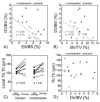The effects of tensile-compressive loading mode and microarchitecture on microdamage in human vertebral cancellous bone
- PMID: 25458150
- PMCID: PMC4303531
- DOI: 10.1016/j.jbiomech.2014.10.011
The effects of tensile-compressive loading mode and microarchitecture on microdamage in human vertebral cancellous bone
Abstract
The amount of microdamage in bone tissue impairs mechanical performance and may act as a stimulus for bone remodeling. Here we determine how loading mode (tension vs. compression) and microstructure (trabecular microarchitecture, local trabecular thickness, and presence of resorption cavities) influence the number and volume of microdamage sites generated in cancellous bone following a single overload. Twenty paired cylindrical specimens of human vertebral cancellous bone from 10 donors (47–78 years) were mechanically loaded to apparent yield in either compression or tension, and imaged in three dimensions for microarchitecture and microdamage (voxel size 0.7×0.7×5.0 μm3). We found that the overall proportion of damaged tissue was greater (p=0.01) for apparent tension loading (3.9±2.4%, mean±SD) than for apparent compression loading (1.9±1.3%). Individual microdamage sites generated in tension were larger in volume (p<0.001) but not more numerous (p=0.64) than sites in compression. For both loading modes, the proportion of damaged tissue varied more across donors than with bone volume fraction, traditional measures of microarchitecture (trabecular thickness, trabecular separation, etc.), apparent Young׳s modulus, or strength. Microdamage tended to occur in regions of greater trabecular thickness but not near observable resorption cavities. Taken together, these findings indicate that, regardless of loading mode, accumulation of microdamage in cancellous bone after monotonic loading to yield is influenced by donor characteristics other than traditional measures of microarchitecture, suggesting a possible role for tissue material properties.
Figures





References
-
- Bayraktar HH, Keaveny TM. Mechanisms of uniformity of yield strains for trabecular bone. J. Biomech. 2004;37:1671–1678. - PubMed
-
- Bevill G, Eswaran SK, Farahmand F, Keaveny TM. The influence of boundary conditions and loading mode on high-resolution finite element-computed trabecular tissue properties. Bone. 2009;44:573–578. - PubMed
-
- Bevill G, Eswaran SK, Gupta A, Papadopoulos P, Keaveny TM. Influence of bone volume fraction and architecture on computed large-deformation failure mechanisms in human trabecular bone. Bone. 2006;39:1218–1225. - PubMed
-
- Bigley RF, Singh M, Hernandez CJ, Kazakia GJ, Martin RB, Keaveny TM. Validity of serial milling-based imaging system for microdamage quantification. Bone. 2008;42:212–215. - PubMed
Publication types
MeSH terms
Grants and funding
LinkOut - more resources
Full Text Sources
Other Literature Sources

